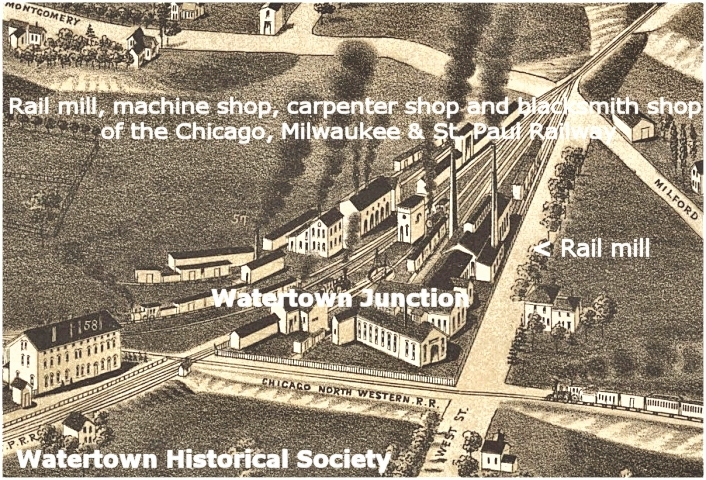website watertownhistory.org
ebook History of Watertown, Wisconsin
Fire at Railway Site
1887

Rail mill, machine shop,
carpenter shop and blacksmith shop of the Chicago, Milwaukee & St. Paul
Railway
Watertown Junction, 1885, 2 years
before the 1887 fire
Watertown Democrat, July 1, 1887
The most
extensive conflagration that ever visited Watertown occurred last Thursday
night [June 23] at 11:30 o'clock, by the burning of the rail mill, machine
shop, carpenter shop and blacksmith shop of the Chicago, Milwaukee & St. Paul Railway
situated at the Junction in the Third ward.
The flames were first discovered by the watchman issuing from the boiler
room of the rail mill, and the application of persons first on the scene of a
number of pails of water found about the building had no effect on the
fire. The structures being all frame and
connected one with the other, except the blacksmith shop, which was brick and
separated from the carpenter shop by a few feet, the destruction of the
building was rapid owing to the inflammable material composing them, and the
dry and tinder-like condition of everything at the time. The Phoenix company with the Silsby engine was promptly on the ground and performed
splendid work as usual, but all the heroic and well directed efforts of the
Phoenix boys were futile to stay the fearful progress of the flames spreading
with rapidity and covering a space so wide as to be beyond the capacity of their
energy to circumvent it.
The Pioneer fire
Company did not reach the fire for some time after the Phoenix boys
arrived on the ground, being delayed by going out of the way on account of
misjudging the location of the fire and to climax the matter the whiffle trees
broke on the route and the horses having to be abandoned, the Ahrens engine had
to be hauled by hand.
To confine the fire
within a small space, was the only hope of getting it under subjection as the
water supply at hand was hardly adequate to cope with a fire of the magnitude
it soon assumed after being first discovered.
Daylight, Friday morning dawned upon the entire plant being a mass of
ruins, thoroughly wiped out with the exception of the brick walls left standing
on the blacksmith shop, the two tall chimneys for the rail mill and a portion
of the lathes and machinery of the machine shop, forming a sad scene of
desolation and destruction, that will ever remain fresh in the minds of all who
with sorrowful hearts witnessed it.
And now as to the
direct results of the fire upon the city.
There was on a average about 200 men employed
in the shops destroyed, putting up a payroll of from $8,000 to $10,000 per
month, and the loss of this to our city will indeed be a severe blow, effecting
seriously the business interests of the place.
Milwaukee Journal, June 24, 1887
1887: Rail Mill and
Shops Fire
FIRE’S LONG HAUL
The St. Paul’s Rail
Mill and Shops Destroyed.
THE LOSS TWO HUNDRED
THOUSAND
The Water Supply Gives
Out at a Critical Moment
One Hundred and Fifty
Men Out of Work
Watertown Wis., June 24
— Last night, shortly before 12 o’clock, a fire started in the rail mill of the
Chicago, Milwaukee & St Paul shops in this city, and before the arrival of
the fire department the flames had made great headway and the heat was
intense.
The steamers were set
at the only tank within the reach, and streams were thrown upon the burning
building, but with little effect. The
fire already involved so much of the spacious building as to have hopeless odds
against two small streams. Nearly all the bells in the city were kept ringing,
and the excited people hastened in crowds to the scene. They could do nothing however but watch the
two jets of water that were steadily lowering the supply in the tank.
At about 12:30 the tank
gave out, and the fire was left to do its work.
So thoroughly was this accomplished, that at 3 o’clock there was little
left to burn. This forenoon, the yard
presents a dismal scene. Nothing but the
smoke-stack remains standing, even the solid walls of the brick engine house
having fallen. The iron braces of the
buildings, bolts rails and other incombustible material lie gnarled and twisted
together half buried in the smoldering ashes.
No buildings besides the railroad shops were burned, though at 1 o’clock
this morning the burning cinders were falling thick and fast, a half a mile
away.
The buildings had stood
many years. Most of them were built
before 1860, and no new ones have been erected for more than fifteen
years. The work which was done in them
has gradually been specialized, however, as the St. Paul system grew. In the rail-mill, in which the fire started,
all the rail-cutting for the entire system was done. In the carpenter and paint shop, all the
windmills, look out-for-the-cars signs, etc., were made, and from the
blacksmith shop the entire system was supplied with frogs (1) and
switches.
The works are a total
loss. No official estimate of their
value has been given, but several contractors and millwrights who were familiar
with the buildings, say that the loss must be about $200,000. It is not known whether the company will
rebuild, but it is the impression that they will. The superintendent thinks that they were very
well insured.
The blow to Watertown
is a severe one, as, even should the shops be rebuilt immediately, the 150 men
would remain in enforced idleness for many weeks. The monthly payroll was about $7,000.
(1) Railroad
frog
![]()
History of Watertown,
Wisconsin